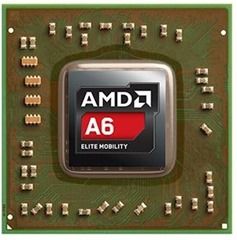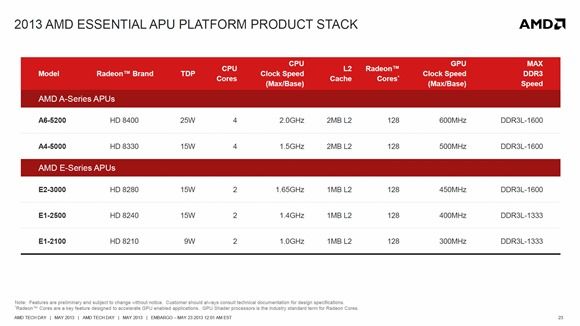 AMD Kabini, based on the new Jaguar Cores, is aimed at the ultrabook-alternative segment. Specifically the A4-5000 and A6-5200 are the quad-core parts at 15W and 25W TDP that will compete against Ivy Bridge and Haswell based Ultrabooks and ‘pro-sumer’ tablets in 2013 and 2014. We’re expecting clock-for-clock performance with the quad-core Kabini platforms on par with (dual core) Ivy Bridge Ultrabook platforms but with a slightly better power utilization figure, especially when when the GPU is under load. However, remember that the A4-5000 is running at 1.5Ghz with no Turbo boost. Real-world performance on that part won’t be up to what we see on Ultrabooks that can sustain 2.4Ghz. Will the A6-5200 be better positioned with 2.0Ghz clock?
AMD Kabini, based on the new Jaguar Cores, is aimed at the ultrabook-alternative segment. Specifically the A4-5000 and A6-5200 are the quad-core parts at 15W and 25W TDP that will compete against Ivy Bridge and Haswell based Ultrabooks and ‘pro-sumer’ tablets in 2013 and 2014. We’re expecting clock-for-clock performance with the quad-core Kabini platforms on par with (dual core) Ivy Bridge Ultrabook platforms but with a slightly better power utilization figure, especially when when the GPU is under load. However, remember that the A4-5000 is running at 1.5Ghz with no Turbo boost. Real-world performance on that part won’t be up to what we see on Ultrabooks that can sustain 2.4Ghz. Will the A6-5200 be better positioned with 2.0Ghz clock?
Test results on an A4-5000 at Anandtech confirm a good but not Ivy Bridge Ultrabook-beating performance level. There’s no great advance in gaming capability for the ultrathin segment and CPU levels are simply on-par with Ivy Bridge. Efficiency is slightly improved on a task-by-task basis meaning that pricing will be the key to success for AMD Kabini, especially as BayTrail and Haswell reach the market in Q3/Q4.
Extrapolating the test figures out to an A6-5200 with HD8400 graphics and a 2.0Ghz clock with 25W TDP you can see some potential for ultrathin designs that match Ivy Bridge and HD4000 but is that enough as Haswell launches and those ‘old’ Ultrabooks start to drop in price dramatically? We don’t think so.
Read the architecture overview and A4-5000 tests at Anandtech and let us know what you think.












I don’t want to knock AMD too much because I think we need them. But it is hard to see volume shipments of their Kabini line when Haswell chips are already going to be in products released / available next month.
Computerbase.de had a very good review of the Kabinis against similar priced Intel chips.
http://www.computerbase.de/artikel/prozessoren/2013/amd-temash-und-kabini-im-test/8/
Also take a look at the improvement in AMD Jaguar Kabini performance power battery life improvements from Legit Reviews. It show new generation of AMD Jaguars dramatically improved performance per watt.
http://www.legitreviews.com/article/2197/4/
Neither Temash or Kabini provide better than HD4000 graphics and while power efficiency is much improved from Brazos/Fusion, you’re only going to see about 1-2 hours more than a equivalent Ivy Bridge product…
Though, the dual core (A4-1200), 3.9W TDP, Temash may see more but it offers less performance than the quad core Temash (A6-1450), 8-14W TDP (with 1-1.4GHz clock for CPU cores and 300-400MHz for GPU), and the version with slightly better graphical performance for the dual core (A4-1250) jumps to 9W TDP…
While Haswell will provide way better than HD4000 graphics with the Iris and Iris Pro GMAs and a claim of 50% improvement in power efficiency will give it the power efficiency advantage if true…
Leaving Temash and Kabini with just a price advantage… Though, features like software for built in motion control, via the camera, may or may not help…
While it remains to be seen how Bay Trail will compare at the end of the year when it comes out to update the ATOM…
How well do these work under Linux? I know Intel has made a lot of progress when it comes to Linux support but I haven’t heard much about AMD when it comes to Linux.
” We’re expecting clock-for-clock performance on par with Ivy Bridge Ultrabook platforms”
Misleading statement, as it requires twice the cores to do so.
Thanks David. I’ve adjusted the text to correct this.
Chippy
HP just announced a new line of ten-point touchscreen notebooks based on AMD Jaguar Kabinis that break through the $400 touch price barrier with a $399 HP Pavilion Touch-Smart 11 and a $529 HP Pavilion Touch-Smart 15 with a 1920×1080.
Also, when coupled with an SSD, the AMD Jaguar Temash and Kabinis outclass all Intel Atoms and win on price performance against Intel Ivy Bridge systems.
as always it seems amd or intel is mainly a techie discussion. in the wild life it will end up like this: for professional usage one goes for intel based devices whereas in consumer markets it ends up with 2 groups of users. the status oriented will run for expensive devices – thus intel – those with smaller budgats will go for prize – thus end up with amd devices (or old intel stuff). in my whole it live i never ever met a consumer who bought a pc ’cause its intel inside. it always was: will it work for the money i have to spend or they did run for “labels” to kick out their money.